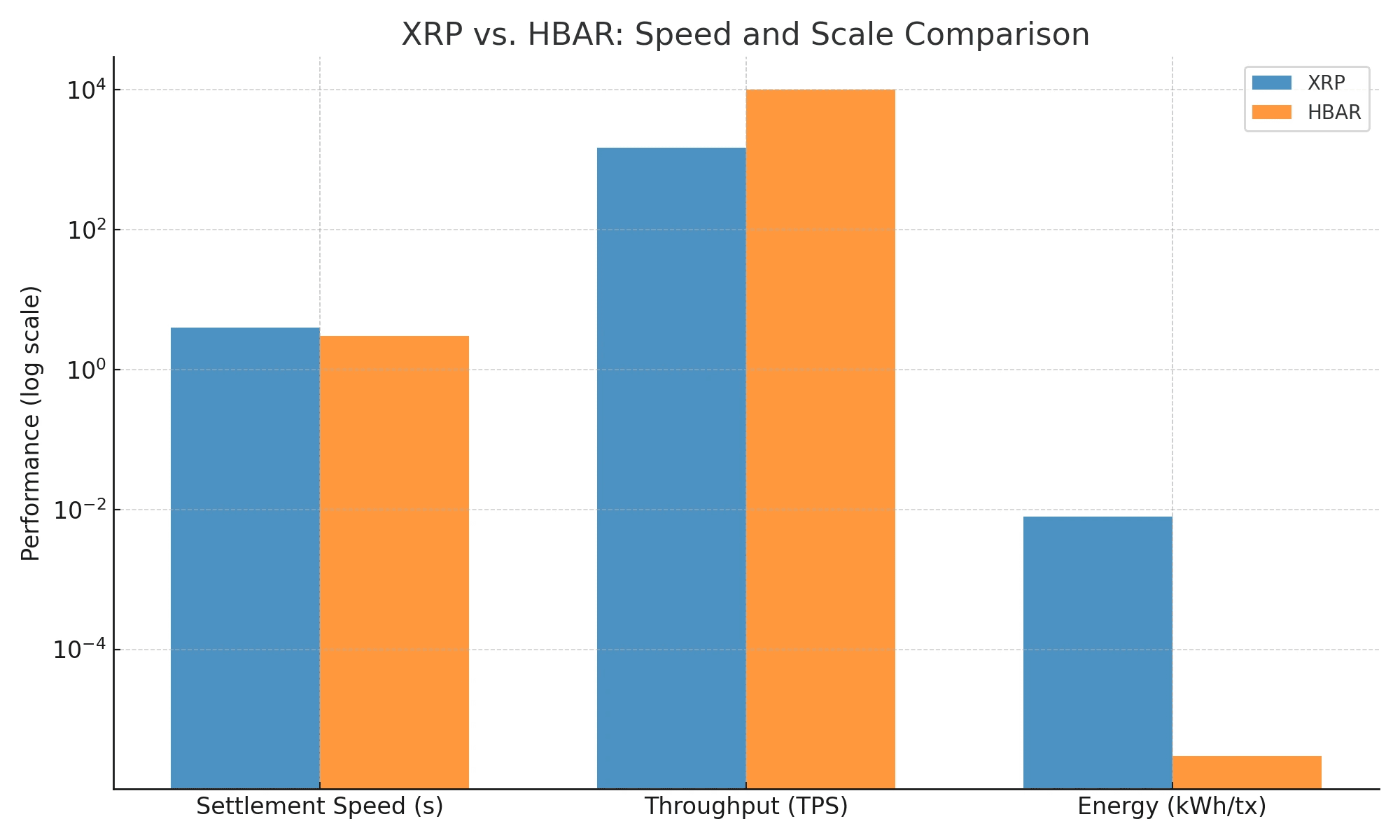SWIFT, the global payment giant – processing over $150 trillion in transactions each year – has officially entered the live blockchain testing phase. Notably, two prominent names in this process are XRP from Ripple and HBAR from Hedera.
This is not just a technology experiment, but also a clear signal that the traditional financial system is rapidly transitioning to blockchain and digital assets. With SWIFT's central role in international payments, any integration could create a huge surge in demand for the chosen coins.
Why Did XRP and HBAR Come Under SWIFT's Radar?
1. Technical Perspective
XRP:
Specifically designed for cross-border payments.
Processes transactions in just 3–5 seconds, with extremely low fees.
Solving the liquidity problem – the biggest bottleneck in international payments today.
RippleNet already has banking and PSP partners (Santander, SBI, Tranglo), making it easier for SWIFT to verify in a real-world environment.
HBAR:
Has extremely high throughput (10,000+ TPS, scalable through sharding).
Best energy performance among leading blockchains (negative carbon).
Uses aBFT + Hashgraph consensus mechanism, both fast and secure.
Suitable for asset tokenization scenarios, data management, and large-scale enterprise transactions – the piece SWIFT is targeting when talking about 'tokenized assets'.

2. Practical Perspective
SWIFT is currently processing over $150 trillion in transactions each year, a huge figure that demands any chosen blockchain solution to ensure stability, high processing speed, and extremely low costs. These are the criteria that both XRP and HBAR are capable of meeting.
In practical terms, XRP has proven its suitability as many banks and financial service providers test it in the international payment system, making it a natural choice for liquidity and cross-border transfer scenarios.
Meanwhile, HBAR builds credibility thanks to a global board comprising top corporations like Google, IBM, Boeing, Nomura, Standard Bank, Shinhan, LG, Ubisoft..., providing the reliability and corporate strength necessary for deployment at an organizational scale. Furthermore, both projects have higher legality and transparency than many other altcoins, making them strong candidates for SWIFT to consider in its transition to blockchain technology.
3. SWIFT's Strategic Perspective
SWIFT is not just stopping at integrating crypto to speed up money transfers, but is also pursuing a more comprehensive strategy.
First of all, the network needs a solution to ensure global liquidity – an issue that XRP can address by acting as an intermediary bridge in cross-border transactions.
Simultaneously, SWIFT is also aiming to build a tokenization infrastructure for traditional assets such as bonds, stocks, fund certificates, CBDCs, or stablecoins, and this is the area where HBAR excels with high performance and business orientation.
More importantly, instead of allowing blockchain to threaten its dominant position in international payments, SWIFT is proactively integrating powerful networks like XRP and HBAR to strengthen its ecosystem, maintaining its central role in global finance in the digital technology era.
Potential Impact on the Market and the Values of XRP, HBAR
The potential impact of this move on the market and the values of XRP and HBAR is extremely noteworthy. If just 1% of the total volume of $150 trillion that SWIFT processes annually is deployed on the blockchain platform, this figure would be equivalent to about $1.5 trillion – larger than the entire current cryptocurrency market capitalization. This means demand for global liquidity (handled by XRP) and technical infrastructure (provided by HBAR) will surge, creating long-term buying pressure for both assets.
In the short term, news of SWIFT testing blockchain has been enough to place XRP and HBAR on the radar of institutional investors, boosting new interest and expectations. More importantly, in the medium and long term, if SWIFT officially chooses one or even both of these coins in its deployment roadmap, this could very well become a crucial catalyst for the next bull run cycle in the crypto market.
Scenarios for the Future
SWIFT's involvement in the blockchain space opens up various scenarios for the future of XRP and HBAR:
XRP Prevails – If SWIFT prioritizes instant payment solutions and liquidity management, XRP will become the central currency in the system, acting as a 'bridge' for cross-border transactions. This will reinforce XRP's position as the coin directly linked to the banking and global payment industry.
HBAR Leads – In the case that SWIFT values scalability, massive processing speed, and tokenization infrastructure, HBAR could become the backbone of the 'new financial internet', where traditional and digital assets coexist, trading seamlessly on the blockchain.
Hybrid Model – This is seen as the most likely scenario: XRP and HBAR coexist. XRP handles payment and liquidity functions, while HBAR provides the tokenization and enterprise governance platform. This combined model not only reflects the diverse needs of the global financial system but also offers more stability and flexibility than relying on a single network.
In reality, SWIFT's blockchain testing marks a significant turning point in the digitization of global finance. Whether XRP or HBAR takes the lead, or both are adopted, the overall scenario remains that massive capital flows could enter the crypto market in the coming years.
For investors, this is not just a technological advancement but also a long-term strategic opportunity. If SWIFT implements blockchain on a large scale, XRP and HBAR could very well become the two central assets of the global digital finance, and their market values will grow to reflect this role.


